'Star Trek: Discovery' borrows from 'The Running Man' in season 3, episode 6 'Scavengers'
Hot talking point: Where does homage end and just plain pilfering begin?
Warning: The subspace spoiler inducers are overloading!
The third season of "Discovery" started strong on the streaming service CBS All Access, with one of the best episodes we've seen so far, "That Hope Is You, Part 1." And while no subsequent episode has been as good as that, we have had some great new characters that we want to see more of, like Book (David Ajala), Zareh (Jake Weber) and Kovich (David Cronenberg). We've also had some nice B-plots, that are often more fun than what's happening with the primary plot, like Saru's dining disaster and even the crew's cross examinations last week. Tragically though, opportunities were missed to make the most of these and too much time was yet again spent on overemotional storylines.
And in this week's episode, entitled "Scavengers," there's a lot to unpack, both good and bad, but sadly, mostly bad.
Just seconds into the episode, we see a significant change: the USS Discovery is undergoing a 32nd century refit and is now NCC-1031-A. Starfleet ship registration has become inconsistent to say the least. Originally developed by Michael Okuda, it was meant to allow ships to be identified — regardless of any name change — and indicate when the ship was commissioned, just like ships in the U.S. Navy.
For example, at the end of "The Voyage Home" when the new USS Enterprise was commissioned in 2286, it uses the registry 1701-A and consequently set a new precedent. Obviously a new starship hadn't been built just for them in that short time, it was originally either the USS Ti-Ho (NCC-1798) or the USS Yorktown (NCC-1717) and just renamed, but we don't know which one it was, because the registry was changed too.
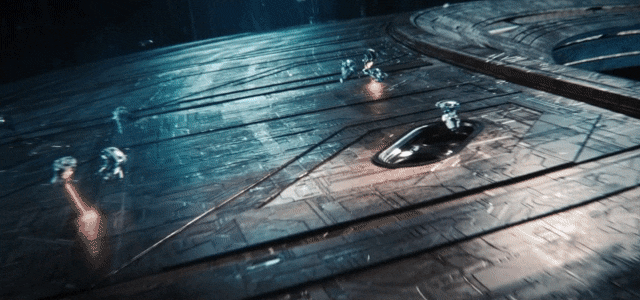
But it doesn't end there. Saru (Doug Jones) provides an expositional log entry: "In the past three weeks, Discovery has evolved even more than we could have imagined. Her battle scars have been healed, internal systems updated, programmable matter has been integrated with our pre-burn technology. Even her nacelles are now detached, improving maneuverability and enabling us to be more efficient in flight…"
"Detached nacelles..?" To quote another sci-fi franchise, I have a bad feeling about this.
It's also worth noting that the USS Discovery that Craft (Aldis Hodge) finds in the "Short Trek" episode "Calypso" has the registry number NCC-1031 and definitely does not look like it has "detached nacelles." Moreover, why was this necessary? The nacelles form the essence of the warp drive engines, not impulse, and hardly anyone is going to warp. The Discovery is relying on its spore drive and that doesn't have anything to do with the nacelles.
Get the Space.com Newsletter
Breaking space news, the latest updates on rocket launches, skywatching events and more!
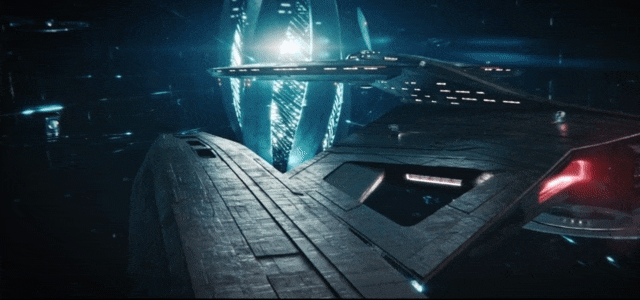
Admiral Vance (Oded Fehr) holds a roll call-style meeting with his starship captains to hand out assignments. Discovery is told to stand by in case the Emerald Chain AKA the Orion-Andorian Syndicate makes an aggressive move to the planet Argeth. Since this means very little to us, we're hoping further explanation will be provided at some point.
The awful advances in technology continue as the crew gush over their new Starfleet badges that now incorporate a comlink and personal transporters, plus hologram user interfaces and a built-in tricorder. The consoles have also been upgraded to incorporate that dreadful-looking new interface tech that Book had on his ship. This all means it's probably time to dial down sensitivity on the technobabble sensors.
How much time was spent researching future control interfaces? Was any time spent researching future control interfaces? According to Lt. Wiilla (Vanessa Jackson) the programmable matter has been incorporated into the existing console design and adapts to each crewmember. What about thought control? When this far-future tech is exhibited, you literally open the floodgates for possibilities and the real potential is seldom seen. It's a risky area to venture into and is rarely handled well.

At this point a signal is received from a ship outside the Federation HQ's protective bubble and it's Grudge, bless, who's flying Book's ship on autopilot. Saru and Commander. Burnham (Sonequa Martin-Green) watch a prerecorded message from Book. Apparently he's stumbled upon a black box flight recorder from an old starship wrecked by the burn on the planet Hunhau, but he programmed the ship to take Grudge to Burnham should anything happen to him, and this was recorded three weeks ago. According to Burnham these remaining, recoverable black boxes indicate that the burn wasn't instantaneous across the galaxy and thus had a point of origin, which she hopes to eventually pinpoint.
Naturally, Burnham wants to hotfoot it off to Hunhau, which creates yet another predictable clash of personalities between her and Saru, who of course has been ordered to stay put in case of something or other. She goes to Georgiou (Michelle Yeoh), basically the only person who will support her on an unsanctioned mission and naturally she's up to the challenge. Roll opening credits.
As the two of them streak through space in Book's ship, Georgiou questions Burnham about her relationship with the most charming and covetable courier in the Alpha Quadrant and, like we've seen Book react when similarly quizzed, her reaction is more akin to a teenager than an emotionally experienced adult human being. It jars somewhat and in an attempt by the writers to make them both appear enamored with each other, they have instead made them look like 10th grade adolescents. At this point, Georgiou starts having fragmented flashbacks to what looks like the events from her time in the Terran Empire. However, she quickly dismisses them.
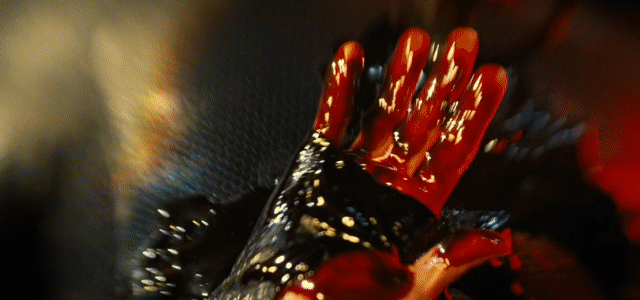
As Burnham and Georgiou approach Hunhau, they're contacted by an Orion, Tolo (played by Noah Averbach-Katz, Mary Wiseman's husband, no less) an operative of the so-called Emerald Chain. Georgiou does her big, bold, bad routine and he eventually allows them to land and they fly down to what looks like a giant scrapyard/old steelworks where people who "owe Osyraa" — the head of the Emerald Chain — are imprisoned. They make their way through the run-down facility, past furnaces and "workers" breaking down old tech and pretend they're looking for specific items, offering their dilithium in return. Burnham pretends to be Georgiou's subordinate and uses a device given to her by Book to locate him and we assume he had something similar, which is how his ship found the hidden Federation HQ.
Finally we find Book, who's being held captive and being forced to do manual labor. He's carting some scrap metal about and at the same time trying to offer a Bajoran named Lai (Daniel Jun) — who looks like he's close to cracking — some positive encouragement. He speaks to an Andorian (played by Ian Lake) who's implanting some weird device on the back of all the prisoner's necks. We learn through helpful exposition that he's being forced to do this against his will and he lost both his antennae as punishment when he resisted Osyraa.
At this point, the worse-for-wear Lai tries to surreptitiously steal an extra water ration and his spotted by a guard. The set piece that follows is … bizarre. Book attempts to defend him and as Georgiou and Burnham helplessly look on, Tolo forces the terrified Bajoran to run outside to … er, "see if the security perimeter is operational" shooting in his direction to encourage him to run faster. Left with no choice, poor Lai runs until he passes a perimeter marker and his head explodes.

And so the reason this is bizarre is because it's practically lifted straight from "The Running Man."
Made it 1987 and directed by Paul Michael Glaser, "The Running Man" stars Arnold Schwarzenegger and was based on an early Stephen King novel about a dystopian America where criminals, political or otherwise, must compete on a gladiatorial TV game show for their lives. Following a brief flashback, the movie begins at the Wiltshire Detention Center in the ruins of Los Angeles following "the big quake of '97." It's a big scrap yard/steel works and inmates are engaged in manual labor: welding pipes and construction of some sort. Escape attempts are prevented by the use of a collar that the prisoners must all wear and an electro-magnetic perimeter that, if crossed while it's still active, causes the collar to explode. Instant decapitation.
Quite often the influences on either the writer or director, or both, are understated and even debatable, and often they borrow from past "Trek," which is nice, but this…isn't even subtle. A homage adds something of value, either a new perspective or a better development. This goes beyond that; the premise is the same, the effect is the same and even the setting is practically identical. Bryce Dallas Howard included a homage to the movie "Apollo 13" in last week's episode of "The Mandalorian" — this is not even close.
Surely an alternative device could've been created to prevent the prisoners from escaping: an ankle bracelet, escort boots, an incapacitation device like Valkyrie uses in "Thor: Ragnarok" or just a collar that doesn't make your head explode. Plus it's not even a quality moment to borrow from; in the movie it's purely to satisfy our morbid fascinations so we can see what happens when some poor soul crosses the perimeter while it's still up. And while we do occasionally like a bit of violence, this feels like a cheap shot.
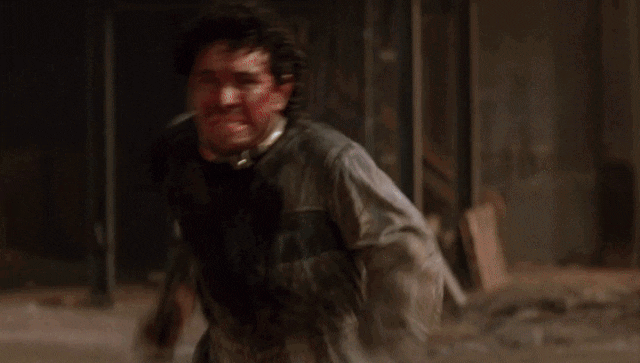
Meanwhile, on Discovery Ensign Tilly (Mary Wiseman) has discovered Grudge the cat and worked out where Burnham has gone. Adira Tall (Blu del Barrio) is chatting away to her Trill host Gray Tall (Ian Alexander) in engineering, which is nice — but despite other characters even hanging a lantern on this by reminding us that Adira is only supposed to recall the Trill's memories and not their actual consciousness — it still feels odd. Adira has made some modifications to the spore drive and Lt. Stamets (Anthony Rapp) seems pleased with the results. Their conversation moves to the mess hall where the invisible Gray tells Adira he approves of Stamets as a friend. It's a nice scene but maybe just a bit too fluffy.
Back on Hunhau, Burnham and Georgiou work well as a team and hatch their plan to rescue Ben Richards Book. They fashion a makeshift weapon with the parts they've scrounged, but before they can use it, they're surrounded by guards who escort them back to Book's ship. Meanwhile, Book himself has organized a prison break with his antennae-less Andorian colleague and while he's dodging fire on the ground, Burnham and Georgiou have made their move and are attempting to overrun their captors.
At a crucial moment, Georgiou starts having her weird Terran Empire flashbacks again, but manages to overcome them as Tolo escapes by using his personal transporter. They lift off in Book's ship, use the blasters on the guards shooting at the escaping prisoners and Book and his now-wounded Andorian colleague beam aboard, together with the all-important uplink code black box recorder that's the cause of this pickle in the first place.
However, a split-second frame in Georgiou's flashback clearly shows Captain Gabriel Lorca (Jason Isaacs) falling into the super-mycelial reactor core of the ISS Charon in the Season 1 episode "What's Past Is Prologue" (S01, E13) after Georgiou stabbed him through the back with a Terran sword. We've seen how the mycelial network is not bound by the conventional laws of plot writing, so it's entirely possible Lorca has something to do with the burn.
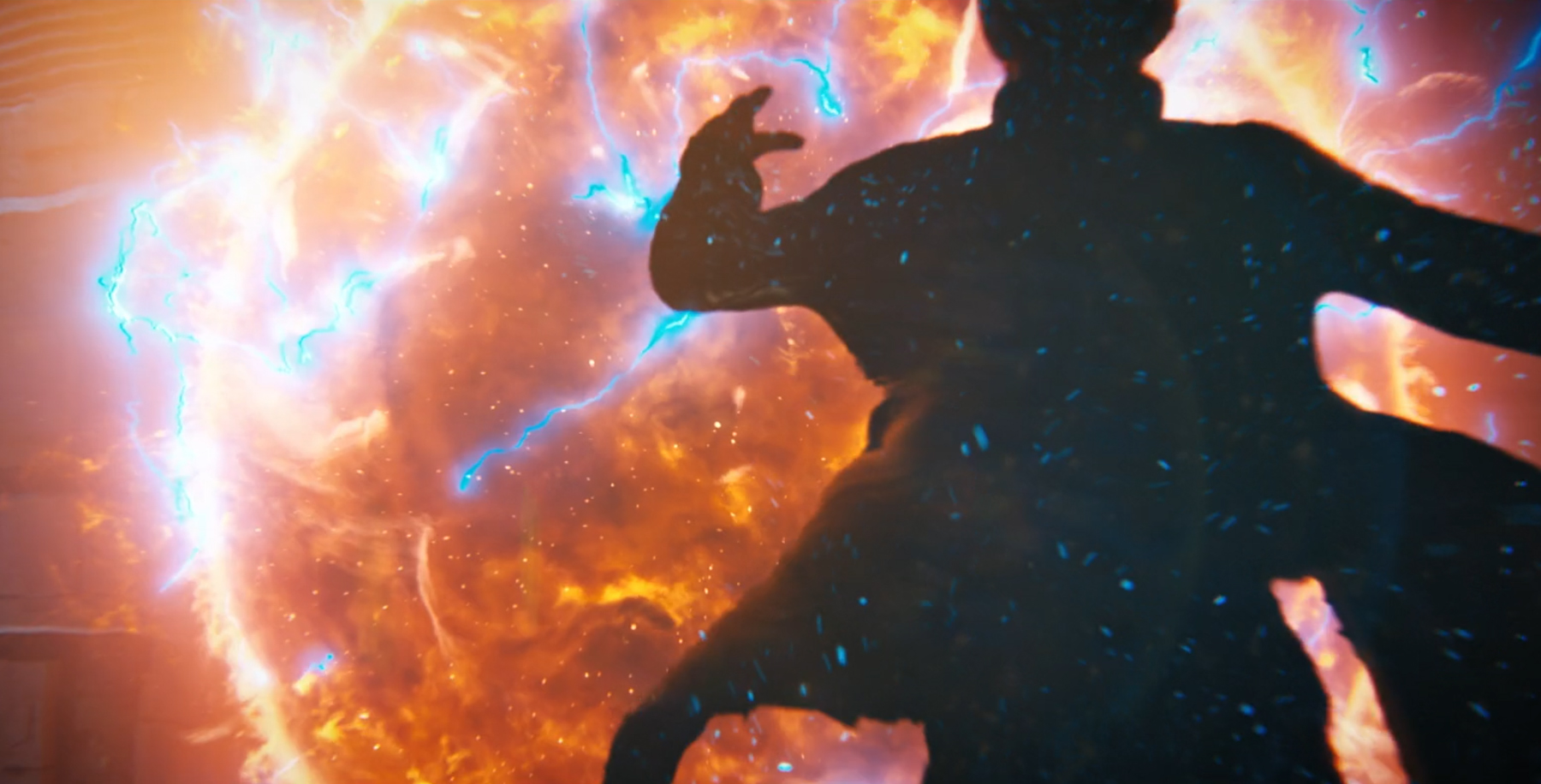
Back on the Discovery, Saru confronts Tilly over Burnham's actions and for all the shocks that this episode contains, this one is genuinely refreshing as the young ensign shows an entirely new level of maturity, agreeing with her captain's opinion and understanding his perspective. Following that meeting, Saru goes to speak to Vance to make it clear that Burnham acted alone and without his knowledge to prevent the whole crew of the Discovery from being tarred with the same brush.
Having returned, Burnham must now face the consequences of her actions, but before that happens, she gets a moment — just about — to finally show how — as we all already know — she feels about Book and they seize the chance for a quick snog in the turbolift. Then she goes to face her destiny. Standing before both Vance and Saru, she is severely reprimanded, but after speaking in her own defense, Vance tells her that the only reason she's not in the brig is that she saved lives and her punishment will be determined by her captain.
Clearly gone are the good old days where risk-taking and "original thinking" were recognized and rewarded by commendations, which is basically how James Kirk became a starship captain. Instead Saru lays the whole I-don't-trust-you-anymore thing down and informs her she will no longer be First Officer. Burnham's Bottom Lip™ quivering, she removes the Starfleet badge from her uniform, despite just being demoted and not relieved of all duties, possibly suggesting she's made her choice, but unlikely. More emotional conflict is inevitable.
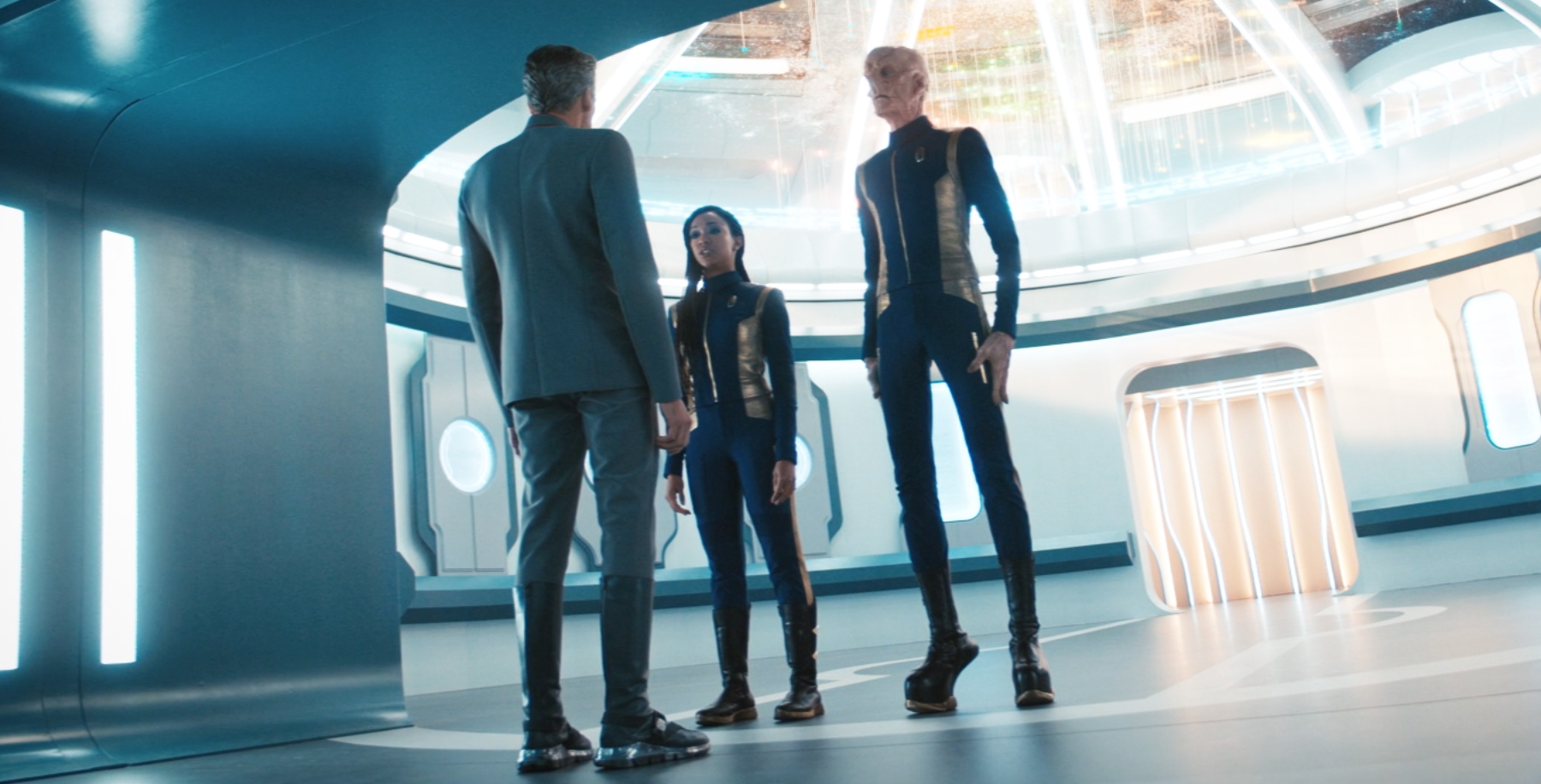
This episode is disappointing, to say the least and the whole "Running Man" thing jars and shows little in the way of fresh ideas. The credited writer for this episode is Anne Cofell Saunders and according to IMDb, she has several episodes of "Battlestar Galactica" and "The Boys" listed under her writing accomplishments, so the capability is certainly there.
"Star Trek" tried to reinvent itself with "Discovery" and it feels like it focused on all the wrong things. We've seen glimpses of genius when "Trek's" at its best, but these moments are few and far between. "Star Wars" for instance was released in 1977 and since then the Millennium Falcon has not suddenly sprouted holographic helm controls. There's a reason why things were kept simple and "Star Trek" could learn from this methodology. It doesn't have an issue with maintaining aesthetic consistency, because it doesn't muck about with that most problematic of sci-fi plots, time travel.
Granted yes, the bridge of the USS Enterprise probably needed an update last season, but suddenly we've had smart matter environment suits, starships equipped with hundreds of repair drones, holographic helm interfaces, even a holodeck in the Season 1 episode "Lethe" (S01, E06). It feels like VFX for the sake of VFX and results in lazy story writing, opting to instead dazzle the viewer with bright colors and shapes added in post-production rather than, say, demonstrating creative world-building beyond a bit of Iceland or Burlington Royal Botanical Gardens.
The good news is that a source involved in the show's production exclusively told us that CBS is currently constructing two AR walls for use on both "Discovery" and "Strange New Worlds." This is the groundbreaking new technology that was developed by a number of VFX companies, including ILM and Pixomodo, and implemented on "The Mandalorian." So hopefully these will be used to help create some interesting, new worlds and environments in the "Star Trek" universe.
Rating: 5/10
Weekend on Rigel II ✓
- Well, er, you know … it was good to see Book again, right?
Imprisoned on Rura Penthe ✗
- NCC-1031-A..?!
- Detached nacelles..?!
- Ripping off "The Running Man"..?!
- That weird block thing that Book's ship does in order to turn around
- Now every Starfleet badge can project a holographic interface [sigh]
CBS All Access is the home of "Star Trek: Picard," "Star Trek: Discovery," "Star Trek: Lower Decks" and a host of other original and archival CBS television shows. Subscriptions start at $5.99 a month. You can try CBS All Access for a week free here.
Follow Scott Snowden on Twitter. Follow us on Twitter @Spacedotcom and on Facebook.
Join our Space Forums to keep talking space on the latest missions, night sky and more! And if you have a news tip, correction or comment, let us know at: community@space.com.
When Scott's application to the NASA astronaut training program was turned down, he was naturally upset...as any 6-year-old boy would be. He chose instead to write as much as he possibly could about science, technology and space exploration. He graduated from The University of Coventry and received his training on Fleet Street in London. He still hopes to be the first journalist in space.










